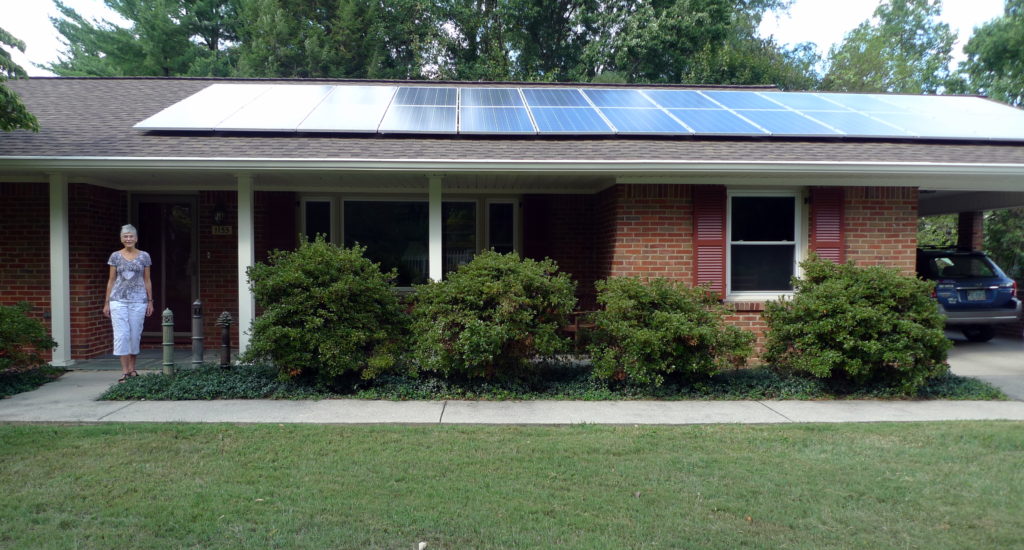Maya Bohler, who lives in Roanoke, has been making functional pottery inspired by nature and the world’s great civilizations since 1979. That means she makes bowls, plates, teapots and other things you can use in the kitchen and around the house with a design that goes beyond the usual.
And solar power helps Maya make pottery in a way that supports an important life value for her — to leave a positive legacy for future generations.
Pottery that’s Art You Can Use
Maya’s pottery is useful but it’s also beautiful. Photos below show Maya at work along with some samples of her work. Click any image to enlarge.
She also makes ceramics that are less functional and more evocative of a far-off place that inspires her.
For example, after a trip to India, she made a series of ceramic minarets like the ones she’d seen at the Taj Mahal. Or, after trekking in mountainous Nepal, she created a series of ceramic stones inspired by the Buddhist Mani stones she’d seen in the Himalayas. You can see examples below. Again, click on any image to enlarge it.
From Switzerland to Roanoke to Solar
Originally from Switzerland, Maya first came to the United States in 1969. At first, she worked at the United Nations headquarters in New York City. It was then that she took a class in ceramics and started making pottery as a hobby. Later, Maya began holding shows and selling her pieces.
Since she was raised in Europe where energy is more expensive, Maya is used to turning off lights, turning down the heat and doing other things at home to save energy and save money.
For years, she’s also cared about the environment but she never thought that she could afford to go solar at home.
“I looked into it at some point and it was too expensive. It didn’t seem affordable for ordinary homeowners. I thought that maybe it was just something for businesses to do.”
Soon after she moved to Roanoke in 2004, Maya set up a pottery studio in her basement and started doing some pottery shows in Virginia. Of course, firing up a pottery kiln uses a lot of electricity and that’s been a challenge for Maya to save energy.
So when she met Laura Wasko of Main Street Solar at a street festival in Roanoke a couple years back, Maya was intrigued.
“I told Laura that I’m not really serious about solar. It’s just too expensive. But Laura told me that prices had come down and also that there was a 30% tax credit to make it even cheaper.”
That was enough for Laura to provide Maya with a proposal to go solar at home. “The price turned out to be very affordable,” Maya says.
Maya even learned from Main Street that her home has a perfect roof to get enough solar to cover her electricity usage throughout the year. So, Maya decided to get started.
Since Main Street was booking installations several months in advance, when Maya signed on with the company in October of 2016 she was told she’d have to wait until March of this year to get her installation. But then, in December, an installation slot time opened up and Main Street was able to squeeze in Maya’s installation before the end of the year — a full three months early, and a pleasant surprise.
“It was like a Christmas present,” Maya says. “It was really exciting. And I could get my tax credit that year. I felt like a pioneer among my friends.”
Saving Money is Nice, but Leaving A Legacy is Better
Main street installed enough solar panels (6.76 kilowatts worth) to cover most of Maya’s electricity usage throughout the year.
Maya explains that she is more frugal about energy than most people, so her bills were not as high as they could have been. Using so little electricity doesn’t mean Maya shivers in the dark, of course. Her hot water heater and stove run on natural gas. Then, to save electricity in the rest of her house, she’s done other things to conserve, including changing out her lightbulbs to CFLs. She’s now changing those bulbs to LEDs.
Before going solar, Maya’s electric bill ranged from a low of about $45 per month in the spring and fall to a high of about $240 in the winter. After getting solar, Maya’s bills for electricity so far have been zero.
Even better for Maya, the position of her roof made it possible to make the panels clearly visible from the front of the house, as you can see in the photo below.

“I was also thrilled that the solar panels were visible from the street. At many houses they’re in the back but at my place they stare people right in the face.”
And that’s just the way Maya likes it.
Though her solar system has only been up a few months so far, Maya’s already gotten a lot of attention for her solar panels. Several friends have asked her about the solar array on her roof — and she’s happy to spread the word. She’s already referred a couple of homeowners to Main Street Solar.
Maya knows her solar panels will be producing electricity for the next 25 years or more. She sees that as her contribution to clean energy and the environment for future generations.
“I want to inspire people to do what they can. We all need to.”
— Andrew Brenner, Main Street Solar















